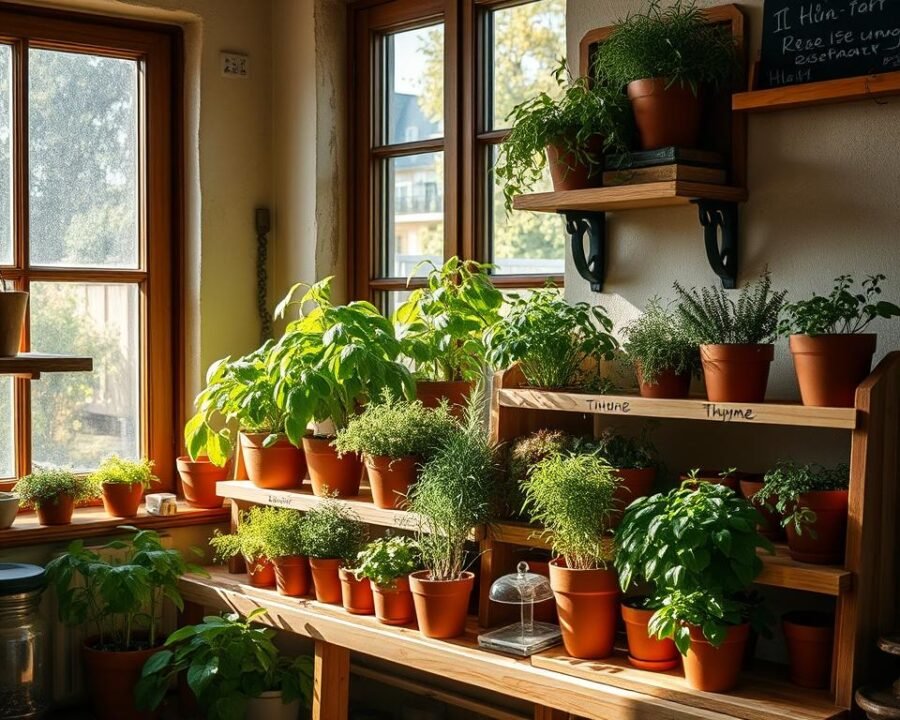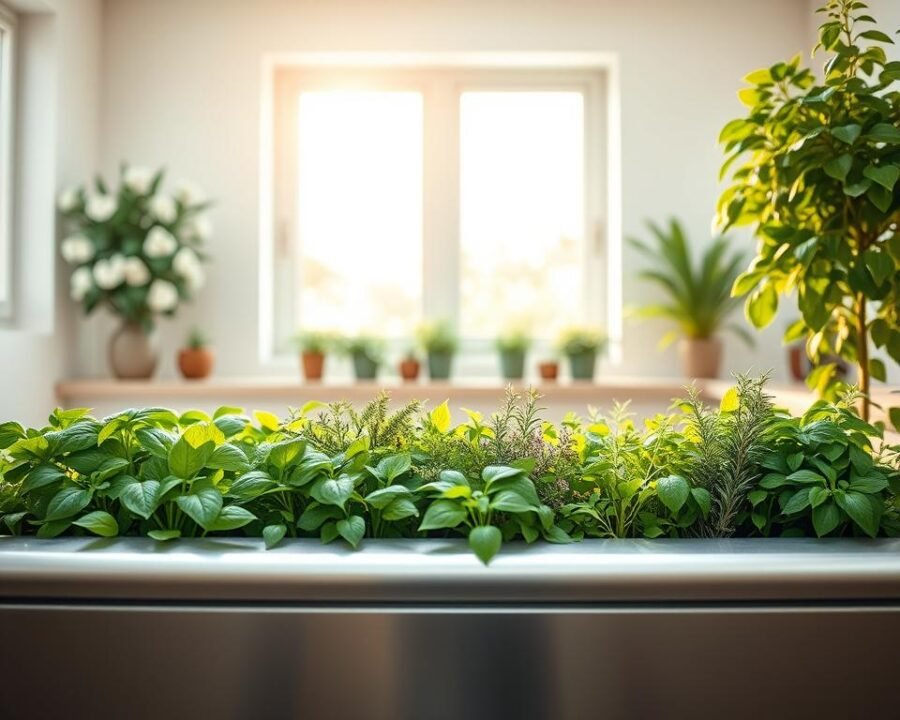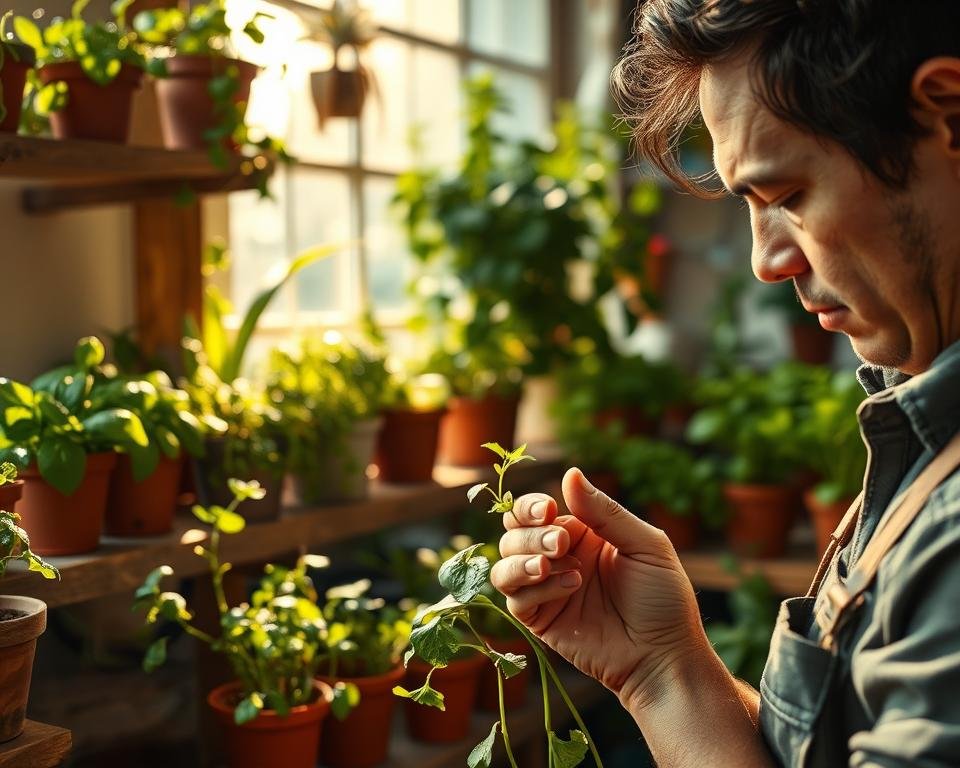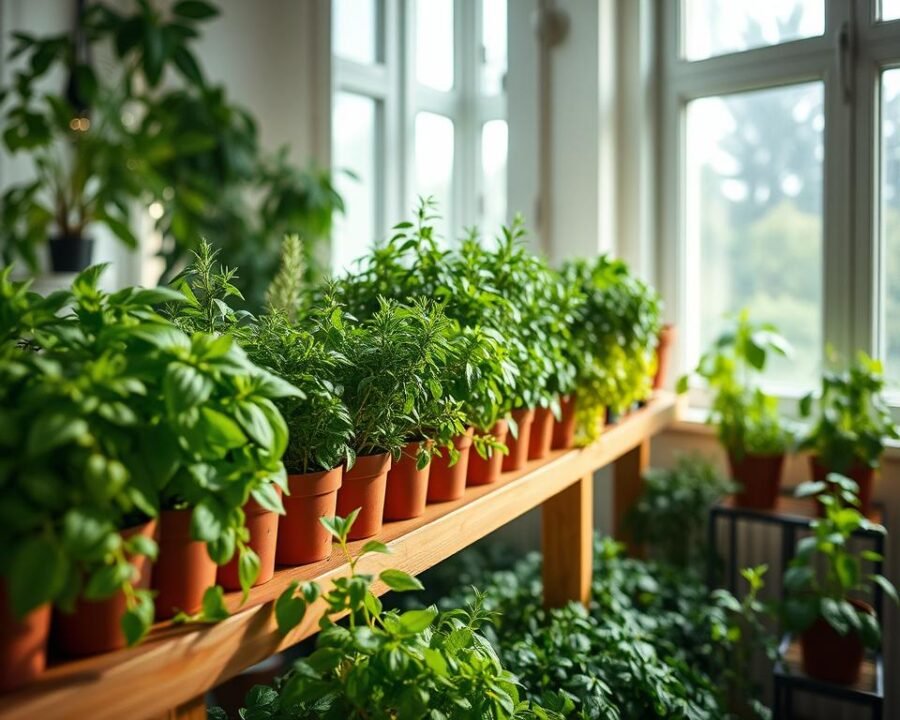There’s something magical about plucking fresh leaves right from your windowsill. The aroma of basil, the crispness of mint—these little joys turn everyday meals into something special. Whether you’re a cooking enthusiast or just love greenery, growing your own herbs at home brings flavor and life to any space.
Modern setups like hydroponics make it easy to nurture plants year-round, even in small apartments. No backyard? No problem. Our curated selection blends functionality with style, offering setups that fit any skill level. From sleek countertop designs to beginner-friendly kits, there’s an option for everyone.
Imagine stepping into your kitchen and snipping fresh rosemary for roasted potatoes or garnishing a cocktail with homegrown thyme. It’s not just about convenience—it’s about savoring the process. Let’s explore how you can cultivate your own little oasis.
Key Takeaways
- Fresh herbs enhance meals and add vibrant greenery to your home.
- Hydroponic systems allow year-round growth, even in limited spaces.
- Options range from compact designs to easy starter kits.
- Perfect for beginners and seasoned gardeners alike.
- Adds both flavor and aesthetic appeal to your living space.
Why Grow an Indoor Herb Garden?
Fresh flavors at your fingertips—no backyard required. A compact setup lets you harvest rosemary, basil, or mint anytime, even in apartments. No more wilted grocery-store bundles or last-minute runs for garnishes.
Save money while elevating meals. Store-bought herbs add up, especially premium varieties like thyme or tarragon. Growing your own cuts costs significantly:
| Herb | Store Price (per oz) | Homegrown Cost (per oz) |
|---|---|---|
| Basil | $2.50 | $0.30 |
| Rosemary | $3.00 | $0.25 |
| Mint | $2.80 | $0.20 |
Beyond savings, live plants purify air. Studies show they reduce toxins like benzene and formaldehyde. A small windowsill planter doubles as a natural air filter.
Gardening also soothes the mind. Tending to greens lowers stress hormones. It’s a mindful escape from screens—water, trim, and watch life grow.
Customize your space effortlessly. Opt for minimalist ceramic pots or a vertical hydroponic wall. Even a repurposed mason jar works. Every home deserves a pinch of freshness.
Essential Factors for Indoor Herb Success
Growing fresh greens inside requires just a few key elements to thrive. Light, space, and your chosen growing method shape the results. Let’s break down what works best for vibrant, flavorful harvests.
Lighting Needs: How Much Sun Do Herbs Really Need?
Most herbs crave 6–8 hours of sunlight daily. South-facing windows are ideal, but east or west-facing ones work too. If natural light is scarce, LED grow lights fill the gap.
Tip: Rotate pots weekly for even growth. Leggy stems signal insufficient light.
Choosing the Right Space: Windowsills, Countertops, and More
Pick spots with consistent temperatures and airflow. Kitchens often win for convenience, but avoid areas near vents or drafts. Vertical planters save space in tight corners.
Soil vs. Hydroponics: Which Is Best for You?
Soil offers a traditional way to grow, with natural nutrient cycling. Brands like Miracle-Gro Indoor Potting Mix simplify the process. Hydroponics skips soil, using water and liquid nutrients for faster growth.
| Feature | Soil | Hydroponics |
|---|---|---|
| Maintenance | Composting, occasional repotting | pH balancing, water changes |
| Growth Speed | Moderate | Up to 30% faster |
| Odor | Earthy scent | Minimal |
Hybrid systems, like self-watering planters, blend the best of both. Choose based on your routine—hands-on gardening or low-fuss automation.
Best Indoor Herb Garden Kits for Every Budget
Turn any corner of your home into a fresh herb haven with these top-rated kits. Whether you’re a novice or a seasoned grower, there’s a perfect match for your space and style.
Click & Grow Herb Gardening Kit
Why it stands out: This sleek system simplifies the process with one-touch controls and pre-seeded pods. Guaranteed germination means no guesswork—just fresh basil or mint in weeks.
The stainless steel finish blends into modern kitchens, while the height-adjustable light accommodates fast-growing varieties. One user raved, “It transformed my cooking—I’ll never buy store-bought again.”
Rise Gardens The Rise Garden
For those ready to invest: This dual-layer vertical design maximizes yield in tight spaces. The companion app sends harvest reminders and pest alerts, making it a tech-savvy choice.
HB Creative Director notes, “I harvest daily for salads—it’s like having a farmers’ market at home.” Integrated lighting even supports winter growth, a game-changer for year-round freshness.
AeroGarden Harvest Elite
Beginner-friendly pick: With a digital display and adjustable LED lights, this kit takes the stress out of growing. The vacation mode feature ensures your compact hydroponic systems thrive while you’re away.
At 17.4″ tall, it fits snugly on countertops. Pre-seeded pods and a foolproof design make it the ideal way to start your green journey.
Creative Indoor Herb Garden Ideas to Maximize Space
Small spaces shouldn’t limit your green ambitions—creativity unlocks endless possibilities. Whether you’re working with a studio apartment or a cramped kitchen, these designs turn limitations into lush, functional displays.
Hanging Planters: Umbra Triflora and Mkono Ceramic
Elevate your herbs—literally. Suspended planters free up countertops while adding visual interest. The Umbra Triflora’s geometric design holds three pots, perfect for a basil-mint-parsley trio.
Mkono’s ceramic versions bring minimalist charm. “They’re sturdy enough for heavy growth but look like art,” notes a Brooklyn urban gardener. Measure ceiling height to avoid low-hanging obstacles.
Vertical Gardens: Tiered and Wall-Mounted Options
Stackable planters or wall pockets multiply growing space without sacrificing floor area. Ideal for plants like thyme and oregano, which thrive in well-drained, airy setups.
- Tiered stands: Rotate shelves for even light exposure.
- Wall-mounted grids: Use lightweight pots to avoid strain.
Windowsill Gardens: Compact and Convenient
South-facing window sills are prime real estate. Opt for shallow-rooted varieties like chives or cilantro. Insulate drafty panes with weather stripping to protect tender roots.
Decorative pots add flair, but self-watering kits (like Lechuza Classico) reduce maintenance. Keep trailing varieties trimmed to avoid blocking sunlight.
“My kitchen window setup lets me snip herbs while cooking—it’s a game-changer.”
Safety tip: Secure heavy planters if pets or kids are around. A well-planned garden blends beauty, function, and peace of mind.
Best Herbs to Grow Indoors
Not all herbs thrive equally indoors—some flourish with minimal care, while others demand precise conditions. Matching varieties to your space and routine ensures vibrant growth and endless flavor. Let’s explore top picks for every lighting scenario.
Easy-to-Grow Picks: Basil, Mint, and Chives
These forgiving plants tolerate occasional neglect. Basil sprouts quickly from seeds, while mint spreads rapidly (use containers to curb its enthusiasm). Chives regrow after cutting, making them a sustainable way to garnish dishes.
- Basil: Prefers 6+ hours of light; pinch tops to encourage bushiness.
- Mint: Thrives in partial shade; perfect for teas and cocktails.
- Chives: Cold-hardy; overwinter indoors near a bright window.
Light-Loving Herbs: Rosemary, Thyme, and Oregano
Mediterranean natives crave full sun. South-facing windows or supplemental LEDs keep them compact. Rosemary’s woody stems add depth to roasts, while thyme and oregano elevate sauces.
“My rosemary bush thrives under a grow light—it’s survived three winters indoors!”
Herbs for Partial Shade: Parsley and Lemon Balm
North- or east-facing windows work well here. Flat-leaf parsley packs more flavor than curly varieties. Lemon balm’s calming properties shine in teas, and its serrated leaves repel pests naturally.
Pro tip: Use humidity trays to mimic outdoor conditions. Rotate pots weekly for even growth.
How to Set Up Your Indoor Herb Garden
A well-planned growing space ensures fresh flavors all year long. Whether you prefer soil or hydroponics, the right foundation makes all the difference. Let’s walk through the essentials for both methods.

Step-by-Step Guide for Soil-Based Systems
Begin with a container that has drainage holes—ceramic or fabric pots work well. Fill it with a lightweight potting mix, like FoxFarm Ocean Forest, to avoid compaction. Gently loosen the roots of starter plants before placing them in the soil.
Water thoroughly until it drains from the bottom, then wait until the top inch feels dry. Pro tip: Add perlite for better aeration. Rotate pots weekly so all sides receive equal light.
Hydroponic Setup: Tips for Water-Based Growing
Hydroponics skips soil, using nutrient-rich water instead. Start with a pH-balanced solution (5.5–6.5) and an EC meter to monitor strength. Algae growth? Block light from reservoirs with opaque materials.
Pumps need cleaning every two weeks to prevent clogs. Transitioning soil plants? Rinse roots gently before placing them in clay pellets. “My basil grew twice as fast after switching,” shares a hydroponic enthusiast.
“Consistency is key—check pH levels every few days for optimal growth.”
Lighting Solutions for Indoor Herbs
Bright, healthy greens start with the right lighting setup—let’s shed some light on the best options. Whether you rely on sunshine or artificial bulbs, consistent exposure keeps flavors potent and leaves vibrant.
Natural Light: South- vs. North-Facing Windows
South-facing windows deliver 6+ hours of direct sunlight, ideal for Mediterranean herbs like rosemary. North-facing ones offer softer light—perfect for shade-tolerant parsley or mint. Rotate pots weekly to prevent lopsided growth.
Tip: Use sheer curtains to diffuse intense afternoon rays. Leggy stems or pale leaves signal insufficient light.
Grow Lights: Clip-On LEDs and Floor Lamps
When sunlight falls short, full-spectrum LEDs mimic natural rays. Aim for 12–14 hours daily. Key features to compare:
- Full spectrum vs. blurple: White LEDs cover all growth stages; blue/red blends suit flowering.
- Daisy-chaining: Link multiple fixtures for larger setups.
- Energy costs: LEDs use ~40% less power than fluorescents.
“My basil doubled in size after switching to a timer-controlled LED—no more guessing game.”
Smart plugs automate schedules, ensuring plants get light even when you’re away. Adjust height as seedlings grow—too close can scorch leaves.
Watering and Maintenance Tips
Keeping herbs thriving indoors starts with mastering their hydration needs. Whether you prefer hands-on care or automated systems, the right approach keeps roots healthy and flavors robust.
Self-Watering Systems vs. Manual Care
Self-watering planters, like Lechuza Classico, use reservoirs to wick moisture upward. They’re ideal for busy schedules or frequent travelers. Manual watering offers more control—perfect for those who enjoy tending to their plants daily.
Compare methods:
- Finger test: Press into soil; water if the top inch is dry.
- Pot weight: Light pots signal thirst; heavy ones mean wait.
- Moisture meters: Affordable tools remove guesswork.
How to Prevent Overwatering and Root Rot
Soggy soil suffocates roots. Ensure pots have drainage holes, and use a mix with perlite for airflow. Signs of trouble:
- Yellow leaves or wilting despite wet soil.
- Musty odor from the garden container.
Recovery steps: Trim rotten roots, repot in fresh soil, and reduce water frequency. For fungal issues, apply a diluted hydrogen peroxide solution (1:3 ratio with water).
“Aeration tools saved my basil—now I check drainage every time I repot.”
With the right way to hydrate, your greens will stay vibrant and productive year-round.
Best Self-Watering Indoor Herb Gardens
Smart hydration systems take the guesswork out of nurturing fresh flavors at home. Whether you’re a frequent traveler or simply forgetful, these setups ensure your greens thrive with minimal effort. Let’s explore top-rated options that balance innovation and simplicity.

Hydroponics Growing System: Precision Meets Convenience
This water-based method delivers nutrients directly to roots, speeding up growth by up to 30%. The included pH solution keeps levels optimal (5.5–6.5), while a seed-starting tray simplifies propagation. Expect 2–3 harvests monthly from basil or mint.
Key perks:
- Starter-friendly: Pre-seeded pods guarantee germination.
- Space-saving vertical design fits kitchens or offices.
- 3-year warranty covers pumps and LEDs.
Rise Gardens Personal Garden: Modular and Tech-Integrated
Ideal for larger yields, this kit supports companion planting (try basil + tomatoes). The app tracks water pH and sends reminders, making it a “set-and-forget” solution. Expand with add-on tiers for more varieties.
| Feature | Hydroponics System | Rise Gardens Kit |
|---|---|---|
| Harvest Frequency | Every 2 weeks | Weekly |
| Customization | Fixed pods | Interchangeable plants |
| Price Range | $120–$200 | $300–$600 |
“My Rise Garden tripled my cilantro output—no more grocery runs for salsa night.”
Both systems elevate everyday food with zero stress. Choose based on your space and how hands-on you want to be.
Unique Indoor Herb Garden Designs
Transform your space with elegant designs that blend form and function. From sleek aquaponic tanks to handcrafted ceramic sets, these setups turn fresh flavors into visual statements. Each option offers a stylish way to nurture plants while enhancing your home.
Aquaponic Tanks: Back to the Roots Water Garden
This self-cleaning ecosystem pairs herbs with fish—a symbiotic design that’s as educational as it is beautiful. The tank’s compact size fits desks or countertops, and the included betta fish adds lively charm.
Key tips:
- Use distilled water to balance pH for both plants and fish.
- Trim roots monthly to prevent overgrowth into the tank.
- Add LED lights if natural light is limited.
Ceramic Trays and Pots: Williams Sonoma Set
Inspired by Ming dynasty aesthetics, these glazed pots elevate any garden. The set includes a matching tray with discreet drainage channels—ideal for sealed surfaces.
Styling ideas:
- Group pots in odd numbers for visual harmony.
- Rotate seasonal decor (e.g., mini pumpkins in fall).
- Anchor lightweight shelves with adhesive strips for safety.
“The glaze develops a richer patina over time—wipe with vinegar monthly to maintain its shine.”
Best Herbs for Culinary Use
Fresh flavors start with the right plants in your kitchen. Choosing varieties that match your cooking style makes every dish shine. Let’s explore top picks for Italian classics and refreshing beverages.
Basil and Oregano for Italian Dishes
These Mediterranean staples bring depth to pasta, pizza, and sauces. Sweet basil works best for pesto, while Greek oregano adds earthy notes to tomato-based recipes. Pro tip: Harvest leaves in the morning for peak flavor.
Prevent cross-pollination by spacing varieties apart. Pinch off flower buds to extend leaf production. Drying methods vary:
- Air-drying: Hang bunches upside down in a dark, ventilated space.
- Dehydrator: Preserves oils better at 95°F (35°C).
Mint and Lemon Balm for Teas and Cocktails
Mojito mint’s bright flavor outperforms chocolate mint in drinks. Steep leaves for cold brew tea—4 hours in cold water yields a smooth infusion. Lemon balm’s citrusy touch elevates iced teas and gin cocktails.
“Freeze mint leaves in decorative ice cubes—they’ll impress guests without diluting flavors.”
Both herbs spread quickly. Grow them in separate containers to avoid overcrowding. For tea blends, dry leaves on screens for even airflow. Store in airtight jars away from light.
Troubleshooting Common Indoor Herb Problems
Even the healthiest plants can face challenges. Spotting issues early and knowing how to fix them keeps your garden thriving. Let’s tackle two frequent problems and their solutions.

Leggy Growth: Fixing Insufficient Light
Stretched stems and sparse leaves often mean your herbs crave more sunlight. Move them to a brighter spot or add a grow light. Rotate pots every few days for even exposure.
Quick fixes:
- Trim leggy stems to encourage bushier growth.
- Use reflective surfaces (like foil) to amplify natural light.
- Set timers for 12–14 hours of artificial light daily.
Yellow Leaves: Addressing Overwatering
Soggy soil is a common culprit. Check roots—if they’re brown and mushy, root rot has set in. Here’s the recovery way:
- Gently remove the plant and rinse roots.
- Trim damaged parts with sterilized scissors.
- Repot in fresh, well-draining soil.
“A moisture meter saved my basil—now I water only when the soil hits the ‘dry’ mark.”
Prevent future issues by letting soil dry slightly between waterings. Self-watering pots can help regulate moisture over time.
Seasonal Care for Indoor Herb Gardens
Seasons change, and so do the needs of your indoor greens—let’s adapt your care routine. Temperature swings and light shifts impact growth, but simple adjustments keep flavors vibrant year-round.
Winter Tips: Supplementing Natural Light
Shorter days starve plants of sunlight. Move pots to south-facing windows or add full-spectrum LEDs. Basil, sensitive to cold, thrives at 65–75°F—keep it away from drafty panes.
AC vent redirection: Tape cardboard deflectors to avoid dry air blasts. Group pots on humidity trays with pebbles and water to mimic tropical air. Note: Misting can invite mold; pebble trays are safer.
“Rotate plants weekly—uneven light causes lopsided growth.”
Summer Care: Managing Heat and Humidity
High temps stress herbs. Use sheer curtains to filter intense noon rays. Rosemary and thyme handle heat well, but parsley and cilantro may bolt—harvest them early.
| Issue | Winter Fix | Summer Fix |
|---|---|---|
| Low Light | LED grow lights | Sheer curtains |
| Dry Air | Pebble trays | Group plants |
| Pests | Neem oil sprays | Sticky traps |
Sunburn prevention: Acclimate garden greens gradually to brighter spots. Watch for bleached leaves—a sign to retreat to shade. Over time, they’ll toughen up.
Dormancy cues: Some herbs (like lemon balm) slow growth in winter. Reduce watering by half until spring. It’s nature’s way of conserving energy.
DIY Indoor Herb Garden Projects
Transforming everyday items into plant homes adds personality to your space. With basic tools and creativity, you can craft unique growing setups that reflect your style. These projects turn recycling into a rewarding way to nurture greenery.
Mason Jar Herb Gardens
Glass jars make perfect mini ecosystems. Use a hammer and nail to create drainage holes in lids—layer pebbles at the bottom for moisture control. Try these combinations:
- Tea station: Mint, chamomile, and lemon balm in matching jars
- Cocktail corner: Basil, rosemary, and thyme for fresh garnishes
Label jars with chalk paint for easy identification. Group them on a tray for easy moving when cleaning.
Upcycled Containers: Creative Planter Ideas
Give old items new life as garden homes. Metal cans work well after removing sharp edges—drill holes using a 1/4″ bit. Mugs without handles become charming kitchen planters.
Vertical stacking systems maximize small spaces:
- Secure wooden crates to a wall with L-brackets
- Line each compartment with landscape fabric
- Add soil and trailing plants like oregano
“Our community swap lets neighbors trade containers—it’s surprising what people will grow in!”
For safety, avoid containers that held chemicals. Test paint for lead if using vintage items. With these ideas, your home will flourish with character and fresh flavors.
Best Indoor Herb Gardens for Small Spaces
Tiny apartments can still host lush greenery with smart design choices. Compact kits and vertical solutions turn cramped areas into thriving garden spots. Here’s how to grow fresh flavors without sacrificing precious space.
Watex Pixel Garden Desktop: Compact and Efficient
This 10″x10″ kit fits on desks or shelves, with stacked trays for multiple herbs. The self-watering base reduces maintenance, while built-in LEDs ensure plants get enough light. “I grow basil and thyme in my studio—no window needed,” says a Seattle user.
Space-Saving Vertical Planters
Wall-mounted or tiered designs maximize vertical real estate. Mkono’s 28.5″ ceramic planter holds five pots without floor clutter. Compare popular options:
| Type | Best For | Installation |
|---|---|---|
| Magnetic Wall Planters | Renters | Sticks to metal surfaces |
| Tension Rod Gardens | Windows | No tools required |
| Foldable Fabric Pots | Balconies | Collapses for storage |
Creative solutions for tight spots:
- Over-door systems: Hang pockets on unused door backs.
- Rotating units: Lazy Susans let herbs follow sunlight.
- Rail-mounted trays: Kitchen shelves double as herb stations.
“My magnetic planters hold parsley and chives—they’re functional decor.”
For renters or tiny homes, these ideas prove size isn’t a barrier. With the right way to organize, even a closet can yield fresh flavors.
Conclusion
Growing your own fresh flavors at home is rewarding and simple. Start with an indoor herb garden kit—focus on lighting, space, and consistent care. Healthy plants thrive with minimal effort.
Begin small. A windowsill of basil or mint proves how easy it is. Over time, expand your garden with hydroponics or vertical planters. Fresh herbs save money and brighten your home.
Share your progress! Tag us in photos of your green corner. Every snipped leaf is a step toward sustainable, flavorful living.
